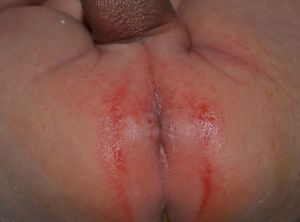We need you! Join our contributor community and become a WikEM editor through our open and transparent promotion process.
Diaper dermatitis
From WikEM
Contents
Background
- Irritant contact dermatitis - the most common skin disorder in infants[1]
- Caused by presence of urine, feces, moisture, friction → breakdown of skin barrier
- Breast-feeding associated with lower rates of severe diaper dermatitis[1]
Clinical Features
- Erythematous, macular and/or papular rash with well demarcated borders
- More severe disease will also have skin maceration and erosions
- Candidal rash will include scaling around margins
- Classic finding is "satellite lesions" in other locations
- Also examine for oral thrush
Differential Diagnosis
Neonatal Rashes
- Atopic dermatitis
- Diaper dermatitis
- Erythema toxicum neonatorum
- Neonatal acne
- Psoriasis
- Seborrheic dermatitis
- Tinea capitis
- Impetigo
- Contact dermatitis
- Perianal streptococcal dermatitis
- Milia
- Miliaria
- Mongolian spots
- Omphalitis
- Pustular melanosis
- Sucking blisters
Evaluation
- Clinical diagnosis, based on history and physical examination
- If erosions or pustules → consider infectious work-up
Management
- Hygiene
- Air drying
- Cleansing regimen (gentle cleaning with water or soap)
- Superabsorbent gel diapers
- Frequent changing
- Barrier creams (zinc oxide)
- Powders (but caution due to risk of aspiration)
- Topical corticosteroids (if resistant to hygiene measures)[1]
- Hydrocortisone cream BID (for no longer than 2 weeks)
- Absorption increased due to moisture and diaper (Cushing syndrome has been reported with overuse)
- Antifungal cream (if suspect candida dermatitis)[1]
- Nystatin cream 100,000 U/gram TID x10-14d (If using zinc oxide cream, apply after nystatin)
- Other options include: clotrimazole, ketoconazole, miconazole, oxiconazole, econazole, sertaconazole
- Miconazole 0.25% cream to affected area with each diaper change x 7 days
- Econazole 1% cream to affected area BID, continue for 3 days after resolution
- Antibacterial therapy (if suspect bacterial infection)[1]
- Mupirocin, bacitracin, polysporin, retapamulin
Disposition
- Discharge
See Also
References
- ↑ 1.0 1.1 1.2 1.3 1.4 Shin HT. Diagnosis and management of diaper dermatitis. Pediatr Clin North Am. 2014 Apr;61(2):367-82.
Authors
Michael Holtz, Ross Donaldson, Brandon Lee, Neil Young, Daniel Ostermayer, Claire

